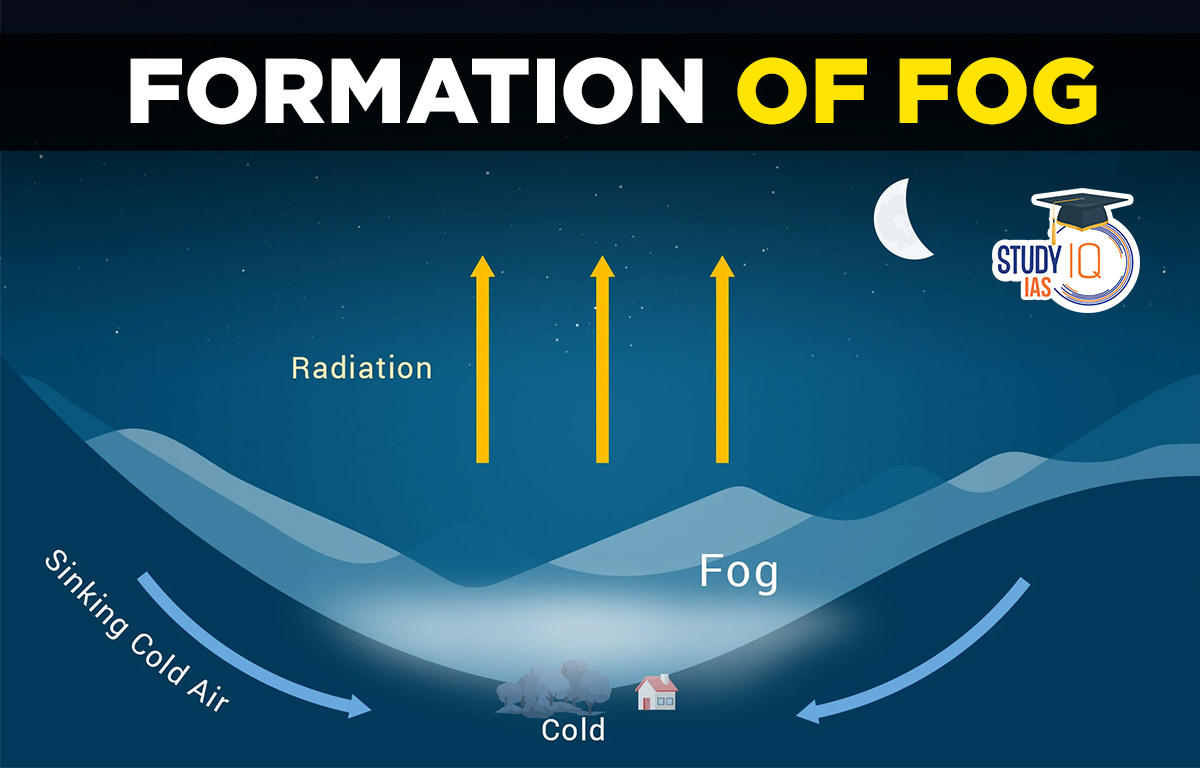Table of Contents
Context: Dense Formation of Fog has enveloped north-western India, including Delhi, Punjab, Haryana, parts of Uttar Pradesh, and parts of Rajasthan.
About Formation of Fog
- Fog is a cloud that touches the ground. It can be thin or thick.
- Formation of fog: Fog forms when water vapour condenses.
- The presence of moisture and a fall in the temperature are key factors for the formation of fog.
- With the land surface cooling down at night, the air close to the surface also cools down.
- Since cooler air cannot hold as much moisture as warm air, the water vapour in the air condenses to form fog.
- Conditions: Fog begins to form in the early hours of the morning, when the temperature is at its lowest.
- Spatial variability of Fog: Areas near water bodies, for instance, may see denser fog because of the higher humidity.

Types of Fog
- Radiation Fog: It forms in the evening when heat absorbed by the Earth’s surface during the day is radiated into the air.
- As heat is transferred from the ground to the air, water droplets form.
- Fog that is said to “burn off” in the morning sun is radiation fog.
- According to SAFAR forecasting system, fog episode in Delhi is categorised as “radiation fog”.
- Advection Fog: It forms when warm, moist air passes over a cool surface.
- When the moist, warm air makes contact with the cooler surface air, water vapor condenses to create fog.
- Advection fog shows up mostly in places where warm, tropical air meets cooler ocean water.
- Valley Fog: It forms in mountain valleys, usually during winter.
- It develops when mountains prevent the dense air from escaping. The fog is trapped in the bowl of the valley.
- Freezing Fog: It happens when the liquid fog droplets freeze to solid surfaces.
- Mountain tops that are covered by clouds are often covered in freezing fog.
- As the freezing fog lifts, the ground, the trees, and even objects like spider webs, are blanketed by a layer of frost.

Fog Episode in North-Western India
- Prevalence of Cold Wave: Cold wave conditions, in which the minimum temperature is significantly lower than normal, have been recorded recently over Punjab, Haryana, and parts of Rajasthan.
- Western Disturbances (WD): It can result in increased moisture levels over the region.
- WD’s are the storms that originate in the Mediterranean Sea and bring moisture-bearing winds to northwest India.
- However, WD’s has not yet brought much moisture and did not lead to any significant fog formation until December 19.
- Other Sources: Local moisture sources like water vapour from rivers and soil moisture can also cause fog.
- Pollution levels and Fog: Delhi being more polluted, records more fog days compared to others.
- As temperature declines, local wind speed falls. The inversion layer comes down and vertical mixing reduces.
- This result in fog formation and particulate matter hangs on the boundary layer, increasing pollution levels.
- Once the temperature increases during the day, the fog dissipates.
IMD Categorisation of Fog
- Fog is categorised as very dense when visibility is between 0 to 50 metres.
- Visibility between 51 and 200 metres identifies fog as dense.
- Moderate fog is identified with a visibility of 201 to 500.
- Whereas, 501 metres to 1,000 metres of visibility is present in shallow fog conditions and 1,000 shallow.
Delhi Fog Characteristics
- According to the India Meteorological Department (IMD), fall in temperature along with moisture and light winds over the Indo Gangetic Plain has resulted in dense fog over the region.
- Indo Gangetic Plain is most vulnerable to fog occurrences, with major, weeks-long spells of dense fog in the months of December and January.
- These foggy spells are linked to wind and temperature patterns.
- Its intensity can depend on factors like humidity, wind, and temperature,
- Variability: According to IMD, fog episodes over Delhi are highly variable.
- It shows very high variability with extreme fog of 25 to 35 days (200 to 285 hours) of dense fog” like in 2017-18. While, on the other hand, in December 2021 — Delhi hardly sees any dense fog events.
- Intensity: Highest number of dense fog (when visibility is less than 200 m) and very dense fog (visibility less than 50 m) days are usually seen in January in Delhi.
- Going by a 31-year average till 2021, Delhi records around 25.3 hours of “very dense” fog in December, and 38.3 such hours in January.
























 WhatsApp
WhatsApp